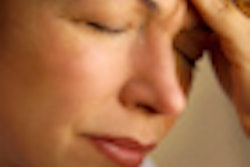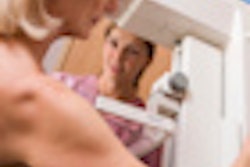
VIENNA - Screening is effective in reducing breast cancer mortality in women ages 40 to 49, but false positives remain a serious problem, European Congress of Radiology (ECR) attendees were told at a special focus session on Friday.
"Should we screen women under 50? I think the answer is yes," noted Prof. Andy Evans, professor of radiology at the University of Dundee, U.K. "Attendance rates are good in younger women, and mammography is not dramatically less sensitive in premenopausal women. But the downside is that screening recalls and screening-provoked surgical biopsies are approximately 50% less specific."
 Prof. Andy Evans, professor of radiology at the University of Dundee, U.K. All images provided by ESR.
Prof. Andy Evans, professor of radiology at the University of Dundee, U.K. All images provided by ESR.
The key questions concern the benefits in terms of mortality reduction and the possible harms in terms of false-positive recalls and surgeries, overdiagnosis, and radiation dose.
Randomized, controlled trials (RCTs) have their weaknesses and are open to criticism, he said. For instance, two Swedish studies showing significant mortality reductions -- Malmö and Gothenburg -- used screening methodology more suited to this age group than some of the other RCTs, particularly multiple rounds, two views, short screening intervals, and modern mammography techniques.
"Women in the control groups in the Malmö and Gothenburg studies were not screened at age 50," Evans stated. "Could the benefits in women aged 40 to 49 at randomization be due to screening episodes for those aged over 50?"
Furthermore, three studies -- Kopparberg, Gothenburg, and Health Insurance Plan, or HIP -- evaluated data based on age at diagnosis rather than age at randomization, and most of the mortality benefit was derived from cancers diagnosed while women were in their 40s.
During the panel discussion, Dr. Sophia Zackrisson, a radiologist from Skåne University Hospital Malmö, Sweden, asked if screening women from the age of 45 or 47 years would be a better solution because most deaths in that age bracket happen in the older women.
 Dr. Matthew Wallis, consultant radiologist and director of the Cambridge and Huntingdon Breast Screening Service in the U.K.
Dr. Matthew Wallis, consultant radiologist and director of the Cambridge and Huntingdon Breast Screening Service in the U.K.
"We tend to look at 10-year groups, but you're absolutely right, cancer gets more common the older you get," replied Evans. "There is no reason we have to include 40-year-old women; it could be 45."
Another delegate asked whether it could be cost-effective to screen women younger than 50. Evans noted that if you look at modeling papers, it matters whether you're looking at life-years saved or mortality. If you're looking at mortality, then no, screening the under 50s is not cost-effective, but if you're looking at life-years saved, then yes, it's cost-effective, he said.
Session moderator Dr. Matthew Wallis, consultant radiologist and director of the Cambridge and Huntingdon Breast Screening Service in the U.K., urged radiologists to be more thoughtful and intelligent and not to forget the two golden rules: Screening is never going to be perfect, and there is always a balance between benefit and harm.
"We rather overdo the positive because there are vested interests. We've got to be more careful about what we say and who we say it to," said Wallis, adding that it is very easy to accept all the sound bites and press comments. "Stop using relative risk and start using point risk."
Radiologists must accept that they will not find some cancers. MRI and ultrasound are very good at detection, but cost is also important. In the drive to find more cancers, we must reduce the harm, he pointed out. More clarity and better communication can help eliminate controversy, chaos, and confusion.
He quoted some examples of sound bites of dubious value:
- She packed your lunch. She tied your shoes. She helped you find your way in the world. Now it's your turn to help your mom. Send mom a mammogram reminder gift.
- If only women paid as much attention as men do their breasts.
- One in every eight women will develop breast cancer.
Originally published in ECR Today March 3, 2012.
Copyright © 2012 European Society of Radiology



















